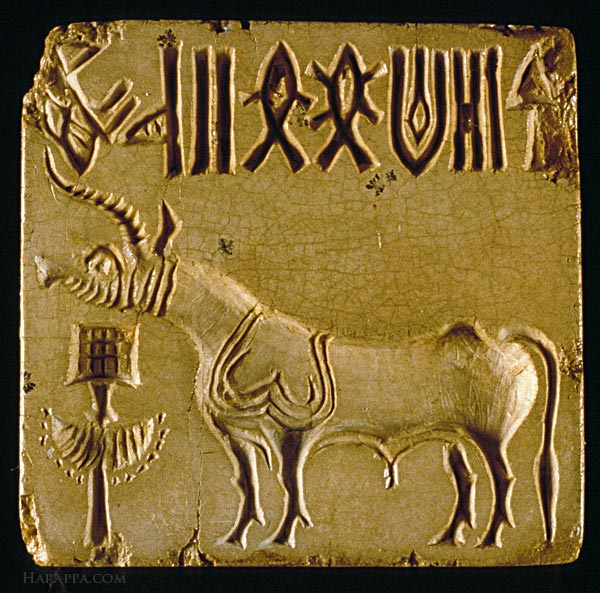
Posted on 01/30/2025 11:46:05 AM PST by Red Badger

The Indus Valley Script usually features an animal accompanied by a short series of signs.
Image credit: Ismoon, Public domain via Wikimedia Commons
Awriting system developed by one of the world’s earliest urban societies has given linguists nothing but grief since it was first discovered on an unintelligible stone seal in the ancient city of Harappa, in what is now Pakistan, 150 years ago. Hoping to finally crack the code, authorities have now announced a $1 million prize to anyone who manages to decipher the so-called Indus Valley Script (IVS).
Also known as the Harappan Script, the IVS was invented by the Indus Valley Civilization which emerged in the region encompassed by northern India and Pakistan some 5,300 years ago. Known for its walled cities, the Bronze Age culture thrived for several centuries before mysteriously vanishing, leaving archaeologists with few clues as to how these ancient people lived.
The first seal featuring the IVS was found by Sir Alexander Cunningham – the founder of the Archaeological Survey of India – in 1875. Engraved on the stone slab was an image of a bull accompanied by two stars and a series of six unreadable characters that Cunningham described as “certainly not Indian letters”.
Several thousand examples have since been recovered, each featuring a central animal and a short sequence of characters. Typically consisting of between four and six signs, the scripts are made more difficult to interpret by their infuriating brevity, with no lengthy inscriptions having been found.
Unlike other ancient writing systems like Egyptian hieroglyphs, the IVS does not feature on any known multilingual artifact such as the Rosetta Stone, which could be used to cross-reference the script with other known languages. However, because all of the examples found so far appear on small items of pottery or stone seals used for commerce, it seems reasonable to assume that their content relates to mundane activities and transactions rather than spiritual concepts.

Little is known about the civilization that invented the script. Image credit: DARSHAN KUMAR/Shutterstock.com Sick of waiting for researchers to crack the code, Muthuvel Karunanidhi Stalin – Chief Minister of the Indian state of Tamil Nadu – has now announced a “cash prize of $1 million to individuals or organisations that decipher the script to the satisfaction of archaeological experts.” With any luck, the incentive will prove as successful as the Vesuvius Challenge, which was launched in 2023 and offered similar rewards to anyone who could reveal the ancient script on a series of charred scrolls from Herculaneum, which was obliterated along with Pompeii by a volcanic eruption in 79 CE.
In that particular example, the script was in a known language – Latin – yet had become illegible after being carbonized by the intense heat produced by the eruption. Within a year of the challenge being set, the grand prize was claimed by a team of entrants who used artificial intelligence to reveal the text without damaging the scrolls, discovering a passage that contained philosophical musings about the pleasure of eating.
If Stalin’s contest can produce a winner, then it may inspire other citizen science initiatives aimed at decoding similarly ancient undeciphered scripts, including the enigmatic "Linear A" writing system devised by the Minoans some 5,000 years ago. Based on the island of Crete, this legendary Bronze Age civilization is often cited as Europe’s first literate society, yet the text it invented has yet to be unlocked by researchers.
Elsewhere, the Rongorongo glyphs found on wooden artifacts on Easter Island have left linguists puzzled by their complete lack of similarity to any known writing system, while the 240-page Voynich Manuscript represents one of the most famous examples of undeciphered text anywhere in the world. Thought to have been written somewhere in Europe around 500 years ago, the mysterious book appears to cover everything from astronomy to botany, yet no one has any idea what it actually says.
it says. “BBQ, next exit”
Where’s my prize?
Eat your ovaltine.
When I tried they just emailed me back a nasty note saying that Ovaltine didn’t even exist back then, screw those people.
PinGGG!................
Ping
Don’t make me turn this chariot around!
We will never know - it’s in cursive
Close, it says “drink your ovaltine.”
And below that “don’t sleep with a crazy woman”, and a picture of this girl O knew from Galveston.
The first picture seems to say “two wives”.
your mistake was assuming it was called ovaltine back then. same formula, different name. but I think you’re right.
I could hypothesize that it may be a very early form of proto-chinese or a branch off of proto-chinese were one went south of the himilayas and one went north
Kilroy was here
The second picture looks like it’s talking about something sexual. Bull penis and then look at the characters. They are suggestive of sexual activity.
“Take two and hit to right.”

:max_bytes(150000):strip_icc()/rao4HR-56a021705f9b58eba4af1a4b-5c5c9fb0c9e77c0001661fcd.jpg )




😆
I saved multiple sheckles by switching my goat insurance to GEICO...
Wasn’t there another thread on this just a little while ago?
I’m having ‘deja vu’.
that first one looks to me like this guy had more than one wife and while it was legal at the time it wouldn’t stop them from from trying to murder each other. or it could be superman is real and when he went back into ancient history to fix something in the future he had to deal with that other guy’s two wives?
Disclaimer: Opinions posted on Free Republic are those of the individual posters and do not necessarily represent the opinion of Free Republic or its management. All materials posted herein are protected by copyright law and the exemption for fair use of copyrighted works.